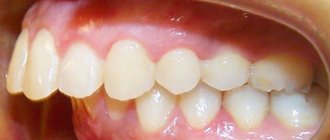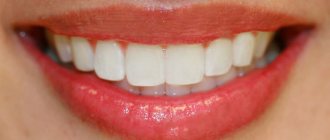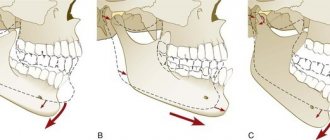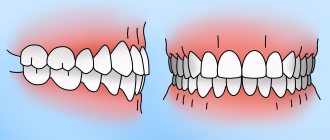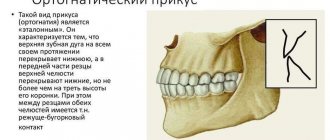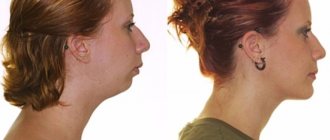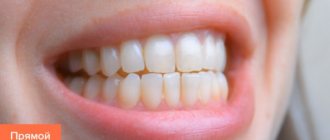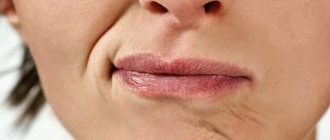Author: Brodsky Sergey Evgenievich Deputy Chief Physician, Candidate of Medical Sciences in the specialties: dentistry and medical microbiology From medical practice it is known that distal occlusion is a complex dentofacial anomaly, which every third orthodontic patient has. The causes, consequences, treatment period for distal bite can be found in this article.
- Distal bite: what is it?
- What if distal bite is not treated?
- Causes of distal bite
- Distal bite: photo
- How to correct a distal bite
- Treatment of prognathia in children
- Correction of distal bite in adults
- Duration of treatment for distal bite
Varieties
In orthodontics there is a classification according to which there are two types of progeny. More details about each of them:
- True. The location of the anterior and lateral dental units is disturbed. A gap forms between the jaws. The defect can be corrected without surgery only in childhood.
- False (senile). The anomaly affects only some central teeth. Occurs mainly in elderly people.
Types of prognathia:
- True prognathia. This type of pathology is rare. The upper jaw is abnormally large. Restoring normal proportions is possible only in children through the use of the Frenkel apparatus.
- False prognathia. The lower jaw sinks deeply. Treatment is orthodontic or surgical.
A – setting of teeth with progenia, b – with prognathia
Causes of progeny and prognathia
All children are born with a distal malocclusion. But in the process of natural feeding, the child actively trains the lower jaw, and over time the bite becomes normal.
At older ages, prognathia occurs for the following reasons:
- artificial feeding;
- prolonged pacifier sucking;
- mouth breathing (for chronic ENT pathologies);
- previous rickets;
- early removal of baby teeth;
- incorrect posture;
- incorrect position of the body and head during sleep.
Progeny can develop due to congenital or acquired factors. Here is a complete list of reasons:
- unfavorable heredity;
- taking certain medications during pregnancy;
- severe illnesses suffered by the mother while carrying a child;
- birth injuries;
- underdevelopment of the jaw bone;
- pathology of the alveolar processes;
- bad habits (finger or upper lip sucking);
- long-term use of the pacifier;
- respiratory system diseases;
- late change of teeth;
- macroglossia (too large tongue);
- complications after surgery in the maxillofacial area.
Forms of prognathic occlusion
There are 4 forms of distal occlusion of the dentition:
- I form – characterized by retrognathia (insufficient development) of the lower jaw, while the upper one is developed normally;
- Form II – macrognathia (excessive enlargement) of the upper jaw bone is observed, as well as the size of the upper crowns being too large. Lower jaw – without deviations;
- III form - 2 anomalies are diagnosed at once - the lower jaw is underdeveloped and the upper jaw is overdeveloped;
- IV form - only the anterior section of the upper dentition protrudes forward.
Symptoms
Progenia is characterized by certain clinical symptoms. Here are the main signs:
- the lower part of the face is voluminous and high;
- chin narrowed or pointed;
- upper lip flattened;
- lower lip slightly turned out;
- pronounced nasolabial folds;
- facial asymmetry;
- absence of a fold under the lower lip;
- elongated nose;
- problems with diction (most often a lisp);
- violation of chewing function;
- teeth have different positions and grow in different directions.
Mesial overbite is common in children, but is rare in adults (after 20 years).
With prognathia, the following symptoms are observed:
- half-open mouth;
- underdevelopment of the lower jaw and its shift back;
- the presence of a longitudinal gap between the incisors of the upper and lower rows;
- visually reduced lower third of the face;
- difficulty mouth breathing;
- diction defects.
The patient’s appearance and the relationship of teeth with progeny
Consequences of progeny and prognathia
Sometimes people do not notice their malocclusion and live with it until old age. But existing violations have a negative impact on health. They contribute to the progression of a number of diseases.
Consequences of progeny:
- dysfunction of the temporomandibular joint;
- pathologies of the digestive tract (due to poor quality of chewing food);
- facial deformities;
- gum disease;
- early tooth decay;
- facial muscle spasms;
- problems with prosthetics.
Consequences of prognathia:
- Diction defects.
- Changing facial proportions.
- Difficulty brushing teeth. Tartar and plaque quickly form, which creates a favorable environment for the proliferation of pathogenic microorganisms.
- Thinning of bone tissue in certain areas due to uneven load on the teeth.
- High risk of developing dental diseases (caries, gingivitis, periodontitis).
Closing of teeth with true and false progeny
Reasons for appearance
Prognathism, as a rule, is a hereditary defect and is either “inherited” from parents who have similar problems, or can occur as a result of improper development of the child’s jaw.
Potential reasons could be:
- improper breathing through the nose in childhood
- incorrect feeding in infancy (if feeding does not imply a load on the baby’s dental-jaw system, this can cause further deviations)
- early change of baby teeth
- Vitamin D deficiency and potential complications after rickets
How to fix
Progenia and prognathia can be corrected, but treatment methods may vary. In childhood, bones are pliable and respond well to therapeutic manipulation.
Methods for treating progeny in children:
- frenulum correction;
- use of occlusal pads;
- myogymnastics (muscle warm-up to optimize their functioning);
- massage of the alveolar process;
- use of plates and activators.
Devices for correcting bites
In adolescents, coping with the defect can be much more difficult. It takes more time and effort than with babies. They are indicated for orthodontic correction using braces, mouthguards or trainers. In parallel with this, it is recommended to visit a speech therapist (if there are problems with speech).
To eliminate the defect in adults, you can use the following products:
- arc devices with intermaxillary traction;
- Bruckle's apparatus;
- braces.
In difficult cases, surgical intervention is indicated. This could be a simple tooth extraction or surgery on the lower jaw.
To treat prognathism in children, specialists use devices that accelerate the growth of the lower row of teeth and inhibit the growth of the upper jaw. These include:
- activator tools;
- compression bandages;
- Frenkel apparatus.
In adults, distal occlusion is corrected with braces. If indicated, surgical intervention may be performed.
Article:
What exactly should you do if the baby has prognathia : the chin is absolutely not “strong-willed”, the lower jaw “crawled” back, and the upper teeth, like those of a rabbit, protrude forward?
Exercises for the lips and lower jaw - myogymnastics, are carried out in parallel with breathing exercises and wearing a vestibular plate (with the visor pointing down). Naturally, during myogymnastics the plate should not be in the baby’s mouth. The exercises are done 2-3 times a day, first for 5 minutes, then for 10-15 minutes, sitting in front of a mirror. Do not take the whole complex at once to work with your child. Start with one or two exercises. When you get good at them, master the next ones, but don’t forget to repeat the previous ones. And it would be a good idea to visit a speech therapist before starting self-study at home. 1. Exercise “Smile”. The lips smile naturally, the teeth are clenched in a “fence”, i.e. The upper teeth “stand” above the corresponding lower ones. The front teeth are clearly visible. Maintain this position for at least 10 seconds (the time lengthens from activity to activity).
2. Exercise “Tube”. The teeth are tightly clenched. Pull your lips forward with a tube and hold in this position for at least 10 seconds (the duration gradually increases).
3. Alternate exercises “Smile” - “Pipe” at the count of “one-two” at least 10-15 times. Teeth are clenched all the time! Take your time! Fix one or the other position of the lips.
4. Exercise “Fish” . The teeth are clenched tightly, the lips are extended forward (see exercise “Tube”). The lips open and close (as a fish does with its mouth in an aquarium).
5. Exercise “Funnel ”. Move the lower jaw forward, open the mouth slightly, and open the teeth. On the count of “one”, pull your lips forward with a “horn”; on the count of “two”, pull your lips inside your mouth, tucking them behind your teeth (the lower jaw is still pushed forward!). Do at least 10 repetitions.
6. Exercise “Annoyance”. Bite your upper lip with your lower front teeth at least 10-15 times. Hold this position for 5-10 seconds. The lower jaw is pushed forward as much as possible.
7. Exercise “Timpani”. The lips are slightly curled behind the teeth inside the mouth. Slap them one against the other, making a characteristic patting sound. The lower jaw is pushed forward as much as possible. Do this at least 10 times.
8. Exercise “Snorting horse ”. Relax your lips and snort, like a horse does. Move the lower jaw forward as much as possible. Do this at least 10 times.
9. Exercise “Deadbolt”. Move the lower jaw forward as much as possible. Move it from side to side at least 10-15 times with maximum amplitude.
10. Exercise “Hide and Seek”. a) “Hide” the upper lip by biting it with the lower front teeth. Only the lower lip is visible, it stretches up towards the nose. Hold in this position for at least 5 seconds (the time to complete the exercise increases from session to session);
b) “Hide” the upper and lower lips, drawing them into the mouth and slightly squeezing them with the front teeth. The lower jaw is pushed forward as much as possible. Hold in this position for at least 5 seconds (the time to complete the exercise increases from session to session).
11. Exercise “Plane” . “Cross” the lower central incisors along the upper lip at least 10-15 times. The lower jaw moves forward and “works” energetically.
How to eliminate progeny?
Correcting progeny (the lower jaw protrudes unnaturally) can be difficult. But regularly wearing a vestibular plate (with the visor pointing upward) and performing articulation exercises (myogymnastics) help cope with this malocclusion.
The child needs to imagine that his teeth and lips are “stubborn doors” that always strive to “skew.”
1. Articulation exercise “Aligning the doors” : a) open your mouth slightly, then, slowly moving the lower jaw back, place the edges of the lower central teeth on the edges of the upper ones, hold this position for 5-10 seconds;
b) open your mouth, then, moving the lower jaw back, compress your lips tightly, slightly biting them with your teeth, hold for 5-10 seconds.
What should you do if one door leaf prevents the other from closing? That's right, take a plane and remove all the “unnecessary”!
2. Exercise “Plane” : “Cross” the upper central teeth along the lower lip at least 10-15 times. The lower jaw moves back and actively “helps” in this work.
3. Exercise “Rabbit”: a) bite the lower lip with your upper front teeth at least 10-15 times. Then grab your lower lip with your upper teeth and hold this position for 5-10 seconds. The upper front teeth are clearly visible during this exercise.
b) try to reach the upper part of the chin with your upper incisors and also lightly bite it. Fix this low position of the upper jaw on the chin and hold it for 5-10 seconds. The upper front teeth are clearly visible.
And now he will play hide and seek with his lips and teeth.
4. Exercise “ Hide and Seek ”: “hide” the lower lip behind the upper front teeth and the upper lip, biting it. In this case, only the upper lip is visible, it seems to hang over the chin, but the upper teeth are not visible. Hold in this position for at least 5 seconds (the time increases from session to session.
With the help of articulation exercises and plates, the child acquires useful skills that help him cope with the pronunciation of difficult sounds, and he develops a correct bite. But you have to be prepared for the fact that wearing the plates and producing sounds will last for several years. This will require enormous patience from parents and children.
Prevention
To prevent progenia and prognathia, experts give the following recommendations:
- timely treat pathologies of the dental system;
- wean children from bad habits (sucking fingers, lips and others);
- control the position of the child’s body and head during sleep;
- monitor the child's posture.
Pregnant women need to be careful about their health. Proper nutrition with the required amount of vitamins and microelements is important. Also, you should try to protect yourself from infections and minimize stress. It is always easier to avoid violations than to deal with treatment later.
Timely detection of progenia and prognathia guarantees simpler and more effective therapy. Therefore, if you have symptoms of mesial or distal occlusion, you should not postpone a visit to the doctor.
Duration of treatment for distal bite
In adults and children, the treatment period for distal occlusion is different. This is explained by differences in the size and mineralization of the bone tissue of the jaws.
In adolescents and children, the treatment period for correcting distal occlusion can take from five to six months to two years. For adult patients, this will take three to six years, including time for orthognathic surgery.
The retention period after completion of orthodontic treatment usually requires a period twice as long as the treatment itself.

